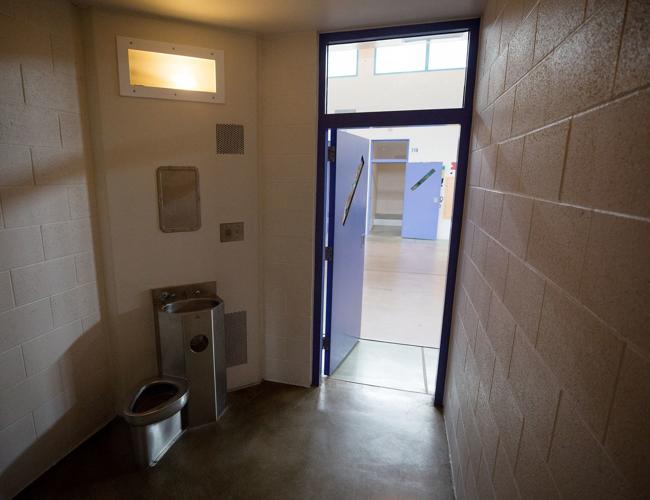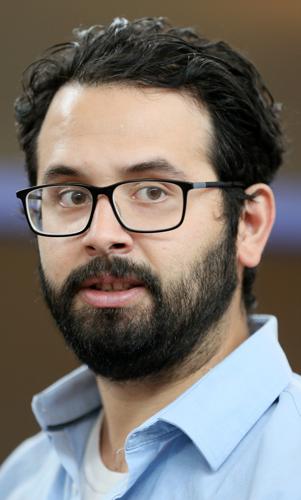Dozens of detention cell doors were thrown open Wednesday morning to show cinder block walls painted white, a simple bed, and a toilet-sink in the corner.
The spartan conditions inside Pima County’s Juvenile Justice Complex are the blank canvas county officials and Catholic Community Services hope to turn into a welcoming sight for migrant families who need a place to stay for a few days.
For the past six months, thousands of asylum-seeking migrants have been cared for at the former Benedictine Monastery in midtown Tucson after being processed and released by federal immigration agencies. But in early August, the former monastery will become residential and retail space.
The 80-year-old former monastery also has been taxed to the limit, leading to rows of portable toilets outside and removed ceiling tiles inside where pipes have burst, said Teresa Cavendish, director of Casa Alitas, a program of Catholic Community Services that has overseen much of the aid effort in recent months.
The tentative plan is to move the shelter operation to three unused wings of the juvenile detention center by Aug. 6. The Board of Supervisors will consider the plan at a July 22 meeting.
On Wednesday, county officials offered the first public view of where they and Catholic Community Services plan to house the families.
The facility is tucked inside a large complex on East Ajo Way. Each wing contains 20 rooms next to a paved yard with a mesh ceiling. Other wings are active detention centers, but county officials said the hallway to those areas will be walled off from the area where migrants would stay.
Migrant families will be free to come and go as they please, Cavendish said. The locks were removed from the cell doors in the unused wings and the surveillance cameras were disabled.
The goal is to make the detention center as welcoming as the former monastery, where children’s drawings are a common sight and volunteers take care of migrant families from Guatemala, Honduras, El Salvador, Brazil and other countries.
To help bring the “warmth” of the local community to the new shelter, Cavendish asked Tucson artisans to step forward, particularly with help painting murals.
Cavendish said volunteers showed photos of the detention center to migrant families at the former monastery and “their primary response was ‘as long as we’re safe and off the streets.’”
Peg Harmon, CEO of Catholic Community Services, acknowledged at a news conference Wednesday afternoon that “there is not universal agreement with the direction we’re attempting to take at this point.” But the looming deadline meant a decision needed to be made.
“We believe that we do not have the additional time or luxury to be uncertain about where we’ll be as our last day at the monastery passes,” Harmon said.
Jessica Rodriguez, a coordinator at the Southside Worker Center, which has been involved in immigrant-rights efforts for many years, attended a lunchtime meeting Wednesday with Cavendish, Harmon, Tucson Bishop Edward Weisenburger and others.
She disagreed with the plan to house migrant families at the detention center.
Last year, churches and nonprofit groups stepped in to “figure it out” and help migrant families, Rodriguez said. The appeal of the former monastery was that it was accessible, but the detention center is not accessible and nothing around it feels welcoming, she said.
“There’s not a green space, there’s not colorful spaces, there’s not even houses around,” Rodriguez said. “We feel safe when we see families around us, when we see children playing on our streets, when we see parks, when we see all these things. That’s not that space.”
Rather than use the detention center, Rodriguez said local groups could step in and house the families until “we find a better location that can serve everyone.”
She pointed to the cost of providing food to the families at the detention center and the likelihood that the food would be highly processed and disagreeable to the families.
The county expects to spend $327,000 in federal dollars to feed migrant families at the detention center in the next five months, partly because of the lack of access volunteers will have to the kitchen inside the secure part of the facility. That estimate is based on three meals per day for 250 people each day.
For meals, the county and Casa Alitas are adopting a “hybrid approach,” Cavendish said. The county will provide one or two meals each day, and volunteers will prepare a main meal that will be “culturally appropriate.”
Since April 21, Catholic Community Services has looked at 25 sites, Harmon said, but they were not able to find a suitable facility other than the juvenile detention center.
Regulatory standards, such as the ratio of bathrooms to people, eliminated many properties, Harmon said. The level of repair needed, cost of modifications, rent, and other factors eliminated the rest.
“The monastery was a vacant building with no furniture when Casa Alitas moved in because the sisters had been gone, and yet today it is a vibrant, loving, warm, welcoming space,” Harmon said.
The tentative agreement with the county includes a $100 annual payment from Catholic Community Services and the option to renew the agreement for several more years.
When asked whether Catholic Community Services viewed the detention center as a temporary fix or a long-term home, Cavendish said it was hard to predict what will be needed.
“We are looking forward to the idea that we can put down roots for a year and really develop the space into something that is well suited to the work that we’re doing,” Cavendish said.












